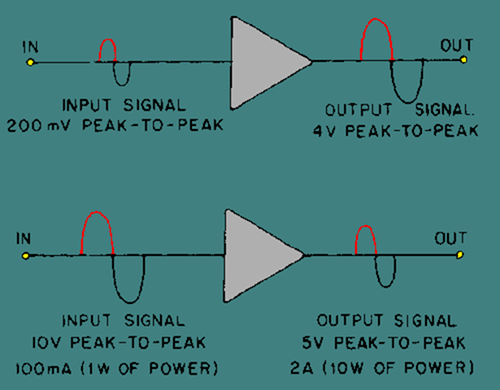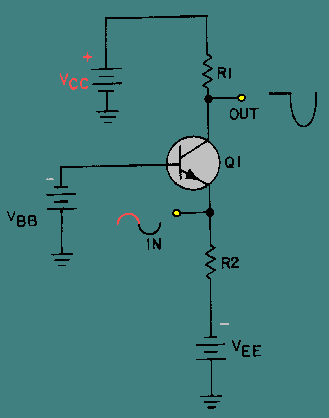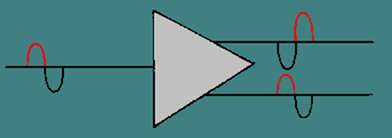AMPLIFIER FEEDBACK
Perhaps you have been around a public address system when a squeal or high-pitched noise has come from the speaker. Someone will turn down the volume and the noise will stop. That noise is an indication that the amplifier (at least one stage of amplification) has begun oscillating. Oscillation is covered in detail in NEETS Module 9, Introduction to Wave-Generation and Wave-Shaping Circuits. For now, you need only realize that the oscillation is caused by a small part of the signal from the amplifier output being sent back to the input of the amplifier. This signal is amplified and again sent back to the input where it is amplified again. This process continues and the result is a loud noise out of the speaker. The process of sending part of the output signal of an amplifier back to the input of the amplifier is called FEEDBACK.
There are two types of feedback in amplifiers. They are POSITIVE FEEDBACK, also called REGENERATIVE FEEDBACK, and NEGATIVE FEEDBACK, also called DEGENERATIVE FEEDBACK. The difference between these two types is whether the feedback signal is in phase or out of phase with the input signal.
Positive feedback occurs when the feedback signal is in phase with the input signal. Figure 1-15 shows a block diagram of an amplifier with positive feedback. Notice that the feedback signal is in phase with the input signal. This means that the feedback signal will add to or "regenerate" the input signal. The result is a larger amplitude output signal than would occur without the feedback. This type of feedback is what causes the public address system to squeal as described above.
Figure 1-15. – Positive feedback in an amplifier.
Figure 1-16 is a block diagram of an amplifier with negative feedback. In this case, the feedback signal is out of phase with the input signal. This means that the feedback signal will subtract from or "degenerate" the input signal. This results in a lower amplitude output signal than would occur without the feedback.
Figure 1-16. – Negative feedback in an amplifier.

Sometimes feedback that is not desired occurs in an amplifier.
This happens at high frequencies and limits the high-Frequency response of an amplifier. Unwanted feedback also occurs as the result of some circuit components used in the biasing or coupling network. The usual solution to unwanted feedback is a feedback network of the opposite type. For example, a positive feedback network would counteract unwanted, negative feedback.
Feedback is also used to get the ideal input signal. Normally, the maximum output signal is desired from an amplifier. The amount of the output signal from an amplifier is dependent on the amount of the input signal.
However, if the input signal is too large, the amplifying device will be saturated and/or cut off during part of the input signal. This causes the output signal to be distorted and reduces the fidelity of the amplifier. Amplifiers must provide the proper balance of gain and fidelity.
Figure 1-17 shows the way in which feedback can be used to provide the maximum output signal without a loss in fidelity. In view A, an amplifier has good fidelity, but less gain than it could have. By adding some positive feedback, as in view B, the gain of the stage is increased. In view C, an amplifier has so much gain and such a large input signal that the output signal is distorted. This distortion is caused by the amplifying device becoming saturated and cutoff. By adding a negative feedback system, as in view D, the gain of the stage is decreased and the fidelity of the output signal improved.
Figure 1-17A. – Feedback uses in amplifiers.

Figure 1-17B. – Feedback uses in amplifiers.
Figure 1-17C. – Feedback uses in amplifiers.

Figure 1-17D. – Feedback uses in amplifiers.

Positive and negative feedback are accomplished in many ways, depending on the
reasons requiring the feedback. A few of the effects and methods of accomplishing feedback are presented next.
Back
Home
Up
Next
Positive Feedback
As you have seen, positive feedback is accomplished by adding part of the output signal in phase with the input signal. In a common-base transistor amplifier, it is fairly simple to provide positive feedback. Since the input and output signals are in phase, you need only couple part of the output signal back to the input. This is shown in figure 1-18.
The feedback network in this amplifier is made up of R2 and C2. The value of C2 should be large so that the capacitive reactance (XC) will be low and the capacitor will couple the signal easily. (This is also the case with the input and output coupling capacitors C1 and C3.) The resistive value of R2 should be large to limit the amount of feedback signal and to ensure that the majority of the output signal goes on to the next stage through C3.
Figure 1-18. – Positive feedback in a transistor amplifier.

A more common configuration for transistor amplifiers is the common-emitter configuration. Positive feedback is a little more difficult with this configuration because the input and output signals are 180° out of phase. Positive feedback can be accomplished by feeding a portion of the output signal of the second stage back to the input of the first stage. This arrangement is shown in figure 1-19.
Figure 1-19. – Positive feedback in two stages of transistor amplification.

The figure shows that each stage of amplification has a 180° phase shift. This means that the output signal of Q2 will be in phase with the input signal to Q1. A portion of the output signal of Q2 is coupled back to the input of Q1 through the feedback network of C3 and R3. R3 should have a large resistance to limit the amount of signal through the feedback network. C3 should have a large capacitance so the capacitive reactance is low and the capacitor will couple the signal easily.
Sometimes positive feedback is used to eliminate the effects of negative feedback that are caused by circuit components. One way in which a circuit component can cause negative feedback is shown in figure 1-20.
In view (A) a common-emitter transistor amplifier is shown. An emitter resistor (R2) has been placed in this circuit to provide proper biasing and temperature stability. An undesired effect of this resistor is the development of a signal at the emitter in phase with the input signal on the base. This signal is caused by the changing current through the emitter resistor (R2) as the current through the transistor changes.
You might think that this signal on the emitter is a form of positive feedback since it is in phase with the input signal. But the emitter signal is really negative feedback. Current through the transistor is controlled by the base-to-emitter bias. If both the base and emitter become more positive by the same amount at the same time, current will not increase. It is the difference between the base and emitter voltages that controls the current flow through the transistor.
To eliminate this negative feedback caused by the emitter resistor, some way must be found to remove the signal from the emitter. If the signal could be coupled to ground (decoupled) the emitter of the transistor would be unaffected. That is exactly what is done. A DECOUPLING CAPACITOR (C3 in view B) is placed between the emitter of Q1 and ground (across the emitter resistor). This capacitor should have a high capacitance so that it will pass the signal to ground easily. The decoupling capacitor (C3) should have the same qualities as the coupling capacitors (C1 and C2) of the circuit. Decoupling capacitors are also called bypass capacitors.
Figure 1-20A. – Decoupling (bypass) capacitor in a transistor amplifier.

Figure 1-20B. – Decoupling (bypass) capacitor in a transistor amplifier.

Regardless of the method used to provide positive feedback in a circuit, the purpose is to increase the output signal amplitude.
Negative Feedback
Negative feedback is accomplished by adding part of the output signal out of phase with the input signal. You have seen that an emitter resistor in a common-emitter transistor amplifier will develop a negative feedback signal. Other methods of providing negative feedback are similar to those methods used to provide positive feedback. The phase relationship of the feedback signal and the input signal is the only difference.
Figure 1-21 shows negative feedback in a common-emitter transistor amplifier. The feedback network of C2 and R2 couples part of the output signal of Q1 back to the input. Since the output signal is 180° out of phase with the input signal, this causes negative feedback.
Figure 1-21. – Negative feedback in a transistor amplifier.

Negative feedback is used to improve fidelity of an amplifier by limiting the input signal. Negative feedback can also be used to increase the Frequency response of an amplifier. The gain of an amplifier decreases when the limit of its Frequency response is reached. When negative feedback is used, the feedback signal decreases as the output signal decreases. At the limits of Frequency response of the amplifier the smaller feedback signal means that the effective gain (gain with feedback) is increased. This will improve the Frequency response of the amplifier.
Q.23 What is feedback?
Q.24 What are the two types of feedback?
Q.25 What type feedback provides increased amplitude output signals?
Q.26 What type feedback provides the best fidelity?
Q.27 If the feedback signal is out of phase with the input signal, what type feedback is provided?
Q.28 What type feedback is provided by an unbypassed emitter resistor in a common-emitter transistor amplifier?
Back
Home
Up
Next
AUDIO AMPLIFIERS
An audio amplifier has been described as an amplifier with a Frequency response from 15 Hz to 20 kHz. The Frequency response of an amplifier can be shown graphically with a Frequency response curve. Figure 1-22 is the ideal Frequency response curve for an audio amplifier. This curve is practically "flat" from 15 Hz to 20 kHz. This means that the gain of the amplifier is equal between 15 Hz and 20 kHz. Above 20 kHz or below 15 Hz the gain decreases or "drops off" quite rapidly. The Frequency response of an amplifier is determined by the components in the circuit.
Figure 1-22. – Ideal Frequency response curve for an audio amplifier.

The difference between an audio amplifier and other amplifiers is the frequency response of the amplifier. In the next chapter of this module you will be shown the techniques and components used to change and extend the Frequency response of an amplifier.
The transistor itself will respond quite well to the audio frequency range. No special components are needed to extend or modify the Frequency response.
You have already been shown the purpose of all the components in a transistor audio amplifier. In this portion of the chapter, schematic diagrams of several audio amplifiers will be shown and the functions of each of the components will be discussed.
SINGLE-STAGE AUDIO AMPLIFIERS
The first single-stage audio amplifier is shown in figure 1-23 . This circuit is a class A, common-emitter, RC-coupled, transistor, audio amplifier. C1 is a coupling capacitor that couples the input signal to the base of Q1. R1 is used to develop the input signal and provide bias for the base of Q1. R2 is used to bias the emitter and provide temperature stability for Q1. C2 is used to provide decoupling (positive feedback) of the signal that would be developed by R2. R3 is the collector load for Q1 and develops the output signal. C3 is a coupling capacitor that couples the output signal to the next stage. VCC represents the collector-supply voltage. Since the transistor is a common-emitter configuration, it provides voltage amplification. The input and output signals are 180° out of phase.
The input and output impedance are both medium.
Figure 1-23. – Transistor audio amplifier.

There is nothing new presented in this circuit. You should understand all of the functions of the components in this circuit. If you do not, look back at the various sections presented earlier in this chapter.
The second single-stage audio amplifier is shown in figure 1-24 . This circuit is a class A, common-source, RC-coupled, FET, audio amplifier. C1 is a coupling capacitor which couples the input signal to the gate of Q1. R1 is used to develop the input signal for the gate of Q1. R2 is used to bias the source of Q1. C2 is used to decouple the signal developed by R2 (and keep it from affecting the source of Q1). R3 is the drain load for Q1 and develops the output signal. C3 couples the output signal to the next stage. VDD is the supply voltage for the drain of Q1. Since this is a common-source configuration, the input and output signals are 180° out of phase.
Figure 1-24. – FET audio amplifier.

If you do not remember how a FET works, refer to NEETS Module 7 Introduction to Solid-State Devices and Power Supplies.
The third single-stage audio amplifier is shown in figure 1-25 . This is a class A, common-emitter, transformer-coupled, transistor, audio amplifier. The output device (speaker) is shown connected to the secondary winding of the transformer. C1 is a coupling capacitor which couples the input signal to the base of Q1. R1 develops the input signal. R2 is used to bias the emitter of Q1 and provides temperature stability. C2 is a decoupling capacitor for R2. R3 is used to bias the base of Q1. The primary of T1 is the collector load for Q1 and develops the output signal. T1 couples the output signal to the speaker and provides impedance matching between the output impedance of the transistor (medium) and the impedance of the speaker (low).
Figure 1-25. – Single-stage audio amplifier.
Sometimes it is necessary to provide two signals that are equal in amplitude but 180° out of phase with each other. (You will see one use of these two signals a little later in this chapter.) The two signals can be provided from a single input signal by the use of a PHASE SPLITTER. A phase splitter is a device that produces two signals that differ in phase from each other from a single input signal. Figure 1-26 is a block diagram of a phase splitter.
Figure 1-26. – Block diagram of a phase splitter.

One way in which a phase splitter can be made is to use a center-tapped transformer. As you may remember from your study of transformers, when the transformer secondary winding is center-tapped, two equal amplitude signals are produced. These signals will be 180° out of phase with each other. So a transformer with a center-tapped secondary fulfills the definition of a phase splitter.
A transistor amplifier can be configured to act as a phase splitter. One method of doing this is shown in figure 1-27.
Figure 1-27. – Single-stage transistor phase splitter.
C1 is the input signal coupling capacitor and couples the input signal to the base of Q1. R1 develops the input signal. R2 and R3 develop the output signals. R2 and R3 are equal resistances to provide equal amplitude output signals. C2 and C3 couple the output signals to the next stage. R4 is used to provide proper bias for the base of Q1.
This phase splitter is actually a single transistor combining the qualities of the common-emitter and common-collector configurations. The output signals are equal in amplitude of the input signal, but are 180° out of phase from each other.
If the output signals must be larger in amplitude than the input signal, a circuit such as that shown in figure 1-28 will be used.
Figure 1-28 shows a two-stage phase splitter.
C1 couples the input signal to the base of Q1. R1 develops the input signal and provides bias for the base of Q1. R2 provides bias and temperature stability for Q1. C2 decouples signals from the emitter of Q1. R3 develops the output signal of Q1. Since Q1 is configured as a common-emitter amplifier, the output signal of Q1 is 180° out of phase with the input signal and larger in amplitude. C3 couples this output signal to the next stage through R4. R4 allows only a small portion of this output signal to be applied to the base of Q2. R5 develops the input signal and provides bias for the base of Q2. R6 is used for bias and temperature stability for Q2. C4 decouples signals from the emitter of Q2. R7 develops the output signal from Q2. Q2 is configured as a common-emitter amplifier, so the output signal is 180° out of phase with the input signal to Q2 (output signal from Q1). The input signal to Q2 is 180° out of phase with the original input signal, so the output from Q2 is in phase with the original input signal. C5 couples this output signal to the next stage. So the circuitry shown provides two output signals that are 180° out of phase with each other. The output signals are equal in amplitude with each other but larger than the input signal.
Figure 1-28. – Two-stage transistor phase splitter.

Q.29 What is a phase splitter?
Back
Home
Up
Next
PUSH-PULL AMPLIFIERS
One use of phase splitters is to provide input signals to a single-stage amplifier that uses two transistors. These transistors are configured in such a way that the two outputs, 180° out of phase with each other, combine. This allows more gain than one transistor could supply by itself. This "push-pull" amplifier is used where high power output and good fidelity are needed: receiver output stages, public address amplifiers, and AM modulators, for example.
The circuit shown in figure 1-29 is a class A transistor push-pull amplifier, but class AB or class B operations can be used. Class operations were discussed in an earlier topic. The phase splitter for this amplifier is the transformer T1, although one of the phase splitters shown earlier in this topic could be used. R1 provides the proper bias for Q1 and Q2. The tapped secondary of T1 develops the two input signals for the bases of Q1 and Q2. Half of the original input signal will be amplified by Q-1, the other half by Q-2. T2 combines (couples) the amplified output signal to the speaker and provides impedance matching.
Figure 1-29. – Class A transistor push-pull amplifier.

Q.30 What is one use for a splitter?
Q.31 What is a common use for a push-pull amplifier?
Q.32 What is the advantage of a push-pull amplifier?
Q.33 What class of operation can be used with a push-pull amplifier to provide good fidelity output signals?
Back
Home
Up
Next
SUMMARY of AMPLIFIERS
This chapter has presented some general information that applies to all amplifiers, as well as some specific information about transistor and audio amplifiers. All of this information will be useful to you in the next chapter of this module and in your future studies of electronics.
An AMPLIFIER is a device that enables an input signal to control an output signal. The output signal will have some (or all) of the characteristics of the input signal but will generally be larger than the input signal in terms of voltage, current, or power. A basic line diagram of an amplifier is shown below.

Amplifiers are classified by FUNCTION and Frequency response. Function refers to an amplifier being a VOLTAGE AMPLIFIER or a POWER AMPLIFIER. Voltage amplifiers provide voltage amplification and power amplifiers provide power amplification. The frequency response of an amplifier can be described by classifying the amplifier as an AUDIO AMPLIFIER, RF AMPLIFIER, or VIDEO (WIDE-BAND) AMPLIFIER. Audio amplifiers have frequency response in the range of 15 Hz to 20 kHz. An rf amplifier has a Frequency response in the range of 10 kHz to 100,000 MHz. A video (wide-band) amplifier has a Frequency response of 10 Hz to 6 MHz.
THE CLASS OF OPERATION of a transistor amplifier is determined by the percent of time that current flows through the transistor in relation to the input signal.
IN CLASS A OPERATION, transistor current flows for 100% (360°) of the input signal. Class A operation is the least efficient class of operation, but provides the best fidelity. 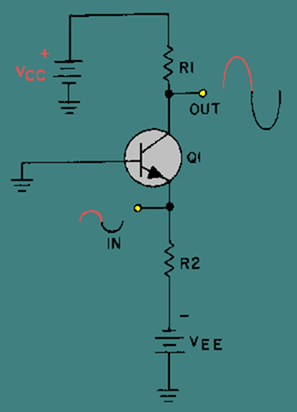
IN CLASS AB OPERATION, transistor current flows for more than 50% but less than 100% of the input signal.
IN CLASS B OPERATION, transistor current flows for 50% of the input signal.
IN CLASS C OPERATION, transistor current flows for less than 50% of the input signal. Class C operation is the most efficient class of operation. 
COUPLING is used to transfer a signal from one stage to another.
DIRECT COUPLING is the connection of the output of one stage directly to the input of the next stage. This method is not used very often due to the complex power supply requirements and impedance-matching problems.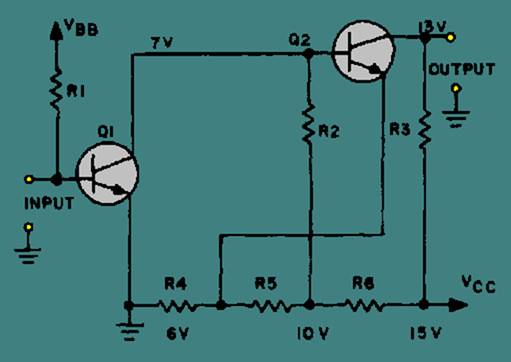
RC COUPLING is the most common method of coupling and uses a coupling capacitor and signal-developing resistors.
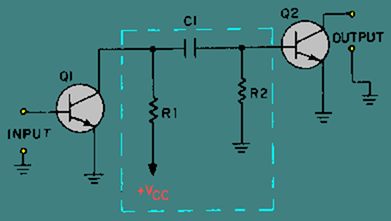
IMPEDANCE COUPLING uses a coil as a load for the first stage but otherwise functions just as RC coupling. Impedance coupling is used at high frequencies.

TRANSFORMER COUPLING uses a transformer to couple the signal from one stage to the next. Transformer coupling is very efficient and the transformer can aid in impedance matching.
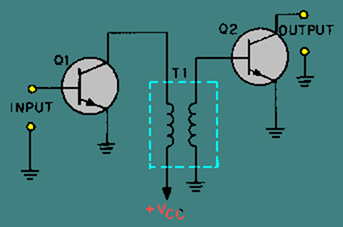
MAXIMUM POWER TRANSFER occurs between two circuits when the output impedance of the first circuit matches the input impedance of the second circuit.
A MAXIMUM VOLTAGE INPUT SIGNAL is present when the input impedance of the second circuit is larger than the output impedance of the first circuit (mismatched).
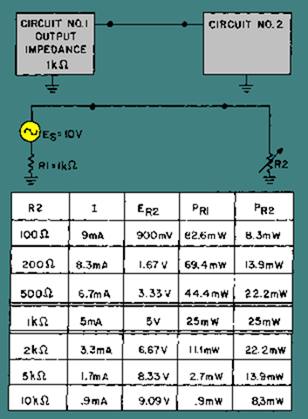
THE COMMON-EMITTER configuration of a transistor amplifier has MEDIUM INPUT AND MEDIUM OUTPUT IMPEDANCE.
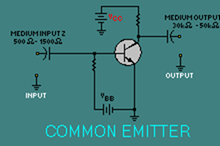
THE COMMON-BASE configuration of a transistor amplifier has LOW INPUT AND HIGH OUTPUT IMPEDANCE.
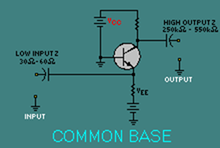
THE COMMON-COLLECTOR (EMITTER FOLLOWER) configuration of a transistor amplifier has HIGH INPUT AND LOW OUTPUT IMPEDANCE.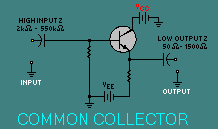
FEEDBACK is the process of coupling a portion of the output signal back to the input of an amplifier.
POSITIVE (REGENERATIVE) FEEDBACK is provided when the feedback signal is in phase with the input signal. Positive feedback increases the gain of an amplifier.
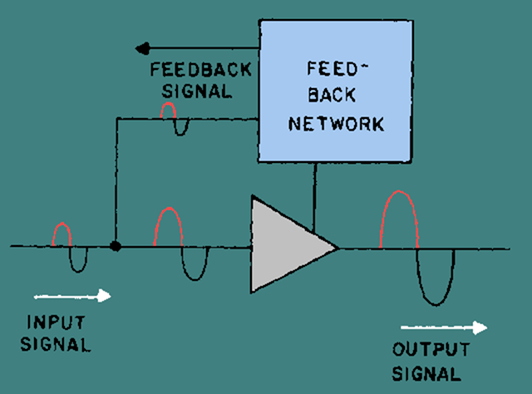
NEGATIVE (DEGENERATIVE) FEEDBACK is provided when the feedback signal is 180° out of phase with the input signal. Negative feedback decreases the gain of an amplifier but improves fidelity and may increase the Frequency response of the amplifier.
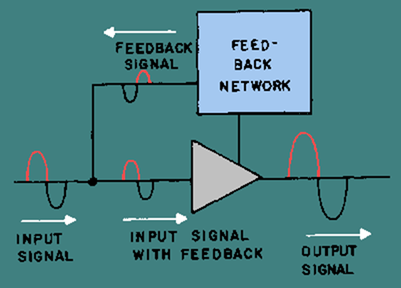
THE IDEAL Frequency response of an audio amplifier is equal gain from 15 Hz to 20 kHz with very low gain outside of those limits.
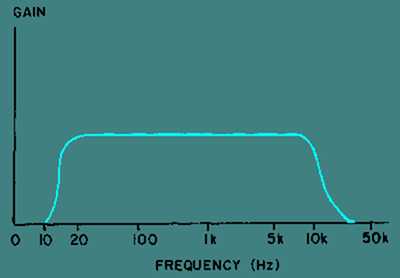
A PHASE SPLITTER provides two output signals that are equal in amplitude but different in phase from a single input signal. Phase splitters are often used to provide input signals to a push-pull amplifier.
A PUSH-PULL AMPLIFIER uses two transistors whose output signals are added together to provide a larger gain (usually a power gain) than a single transistor could provide. Push-pull amplifiers can be operated class A, class AB or class B.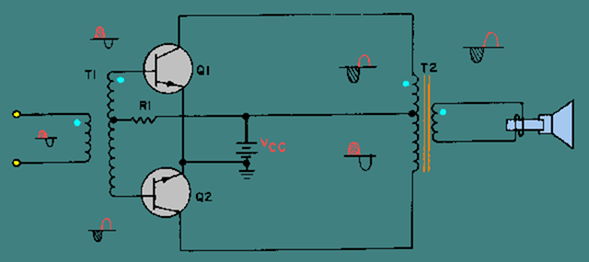
Back
Home
Up
Next
ANSWERS TO QUESTIONS Q1. THROUGH Q33.
A1. Amplification is the control of an output signal by an input signal so that the output signal has some (or all) of the characteristics of the input signal. The output signal is generally larger than the input signal in terms of voltage, current, or power.
A2. No, the input signal is unchanged, the output signal is controlled by the input signal but does not effect the actual input signal.
A3. To amplify the input signal to a usable level.
A4. By function and Frequency response.
A5. An audio power amplifier.
A6. An rf voltage amplifier.
A7. The amount of time (in relation to the input signal) in which current flows in the output circuit.
A8. A, AB, B, C.
A9. Class B operation.
A10. The amplifier operates (and therefore uses power) for less time in class C than in class A.
A11. Class A operation.
A12. To transfer energy (a signal) from one stage to another.
A13. Direct, RC, impedance, and transformer coupling.
A14. RC coupling.
A15. Transformer coupling.
A16. RC coupling.
A17. Impedance coupling.
A18. Equal impedance.
A19. Lower than.
A20. Common emitter-medium input, medium output; common base-low input, high output; common collector-high input, low output.
A21. Common collector.
A22. Transformer coupling.
A23. The process of coupling a portion of the output of a circuit back to the circuit input.
A24. Positive and negative or regenerative and degenerative.
A25. Positive (regenerative) feedback.
A26. Negative (degenerative) feedback.
A27. Negative (degenerative) feedback.
A28. Negative (degenerative) feedback.
A29. A device that provides two output signals that differ in phase from a single input signal. A30. A phase splitter is used to provide the input signals to a push-pull amplifier.
A31. A push-pull amplifier is used when high power output and good fidelity are
needed.
A32. A push-pull amplifier provides more gain than a single transistor amplifier.
A33. Class A, Class AB or Class B operation.
Back
Home
Up
Next





